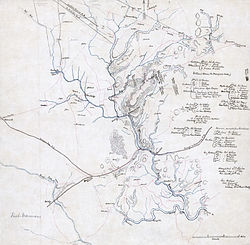Hachure map

Hachures (/[invalid input: 'icon']ˈhæʃʊərz/) are an older mode of representing relief. They show orientation of slope, and by their thickness and overall density they provide a general sense of steepness. Being non-numeric, they are less useful to a scientific survey than contours, but can successfully communicate quite specific shapes of terrain. They are a form of shading, although different from the one used in shaded maps. Hachure representation of relief was standardized by the Austrian topographer Johann Georg Lehmann in 1799.[1] Hachures may be combined with other ways of representing relief, like shades, the result being a shaded hachure map; an example of such a map is the Dufour Map of Switzerland.[2][dead link] Emil von Sydow designed maps with coloured hachures: green for lowlands and brown for highlands.
Overview

Hachures are strokes (short line segments or curves) drawn in the direction of the steepest slope (the aspect direction).[1] Steeper slopes are represented by thicker, shorter and closer strokes, while gentler slopes are represented by thinner, longer and farther apart strokes. A very gentle slope or a flat area, like the top of a hill, are usually left blank. The hachures are traditionally monocolour, usually black, gray or brown; using two complementary colours for the hachures on a neutral background colour (e.g. black and white lines on gray map colour) would give a shading effect as if the relief were illuminated.
Rules
In representing relief with hachures on a map, six rules are to be followed, according to G.R.P. Lawrence (1979):[3]
- The hachures are drawn in the direction of the steepest gradient.
- The hachures are arranged in rows perpendicular to their direction.
- The length and thickness of each stroke represents the drop in height along its direction: a short and thick stroke represents a short and steep slope, while a long and thin stroke represents a long and gentle slope.
- The strokes are spaced at an equal distance inside a row.
- The strokes have the same thickness inside a row.
- If the map is illuminated, strokes are thinner and farther apart on the illuminated side.
The Swiss cartographer Eduard Imhof set 5 similar rules:[4]
- Hachures follow the direction of steepest gradient
- Hachures are arranged in horizontal rows
- Hachure length corresponds to the local horizontal distance between assumed contours of a certain interval
- Hachure width is thicker for steeper slopes
- Hachure density remains constant throughout the map area.
If the illumination is vertical, rule 5 is kept; in the case of oblique illumination, it is dropped. The rules above are to be obeyed for large-scale maps. If the map being drawn is a small-scale map (less than 1:500 000 according to Imhof), rules may be relaxed in order to obtain a more suggestive representation.
References
- ^ a b Patrick J Kennelly and A Jon Kimerling (2001). "New Tools Produce Classic Cartographic Effects". Retrieved 2010-07-22.
- ^ Dufour Map from The Federal Office of Topography of Switzerland
- ^ Elaine R S Hodges, ed. (2003). The Guild Handbook of Scientific Illustration (2nd ed.). John Wiley and Sons. Retrieved 2010-07-22.
- ^ Patrick J Kennelly and A Jon Kimerling. "Desktop Hachure Maps from Digital Elevation Models" (PDF). Retrieved 2010-07-22.
